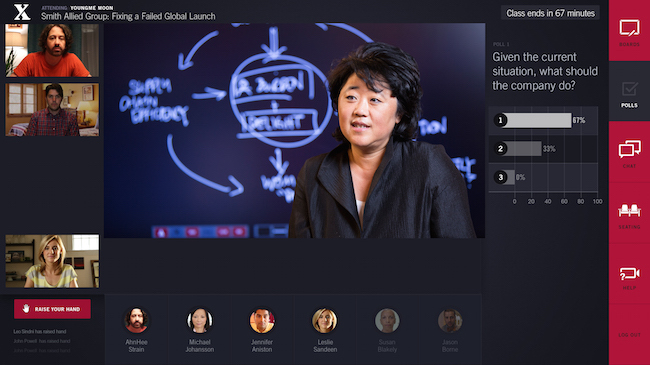What if you could be just 10% better at something? Would that be the difference between winning and losing? Competence or excellence? Could 10% be the catalyst behind your ideas becoming reality or winning trust from your peers and renown in your industry? This 10% improvement is the premise behind Harvard Business School’s new online certificate program Negotiation Mastery: Unlocking Value in the Real World.
Negotiation is perhaps the most used, yet underrated, skill in the MBA toolkit. Every interaction is a negotiation and every term is negotiable. That’s true whether you’re nailing down terms of a partnership or persuading your team to adopt a process. In business, success is often measured in inches, a matter of framing and adjusting as much as it is a matter of compensating and charming. That 10% improvement can be the sweet spot where deals are made and the biggest rewards are reaped, says Michael Wheeler, a professor of management practice at Harvard Business School and instructor for the Negotiation Mastery course.
CASE-DRIVEN AND EXPERIENTIAL, WITH INTENSIVE PEER INTERACTION
“That 10% could be the difference between a deal or a deadlock,” Wheeler observes. “If you get somewhat better, you’re going to be able to make deals that would otherwise slip through your fingers. You’re also going to be more creative. As a consequence, you’ll be able to find solutions that all go to the bottom line. Instead of haggling over price, perhaps you could nudge them on delivery or an ongoing contract where you’re generating mutual value and producing a vastly superior deal than you would have had otherwise.
“It’s a contentious world — we run into conflict. Sometimes, they are small differences within our own organizations. If we can help resolve those before they become costly disputes, that’s a big payoff as well.”
That extra 10% comes in handy in negotiations, often a long and draining process that mixes establishing priorities, making strategic tradeoffs, and maintaining composed diplomacy. Everyone knows the goal of negotiation is to bridge differences and craft win-win agreements that deepen relationships. However, there is a subtext behind many negotiations. Each party is often subject to the pressures and limitations “back home.” Their stakeholders expect them to leverage strengths and exploit weaknesses to strike deals that are shrewdly slanted in their favor. For them, leaving the table altogether may be better than leaving money on it. Such zero-sum thinking, which fosters bad terms and bruised egos, lays the groundwork for more contentious negotiations down the road.
Such scenarios are exactly what Wheeler’s course takes pains to avoid. Everyone has heard the cliché negotiation advice about not making the first offer or never getting caught up in emotion. Such nuggets, Wheeler says, are poor substitutes for preparation, practice, and reflection — the negotiation pillars he has taught for more than three decades. Indeed, his course brings together everything that makes Harvard a leader in business education: case-based instruction, hands-on learning, intensive peer-to-peer interaction, and teaching from the top minds in the field. “The idea of this course is to use both the head and the heart,” says Patrick Mullane, executive director of HBX, the school’s online initiative. “While there is a process aspect to negotiation, there is an emotional and qualitative aspect to it as well. The course tries to get to both things.”
‘THE ANTITHESIS OF READING A BOOK AND HEARING A LECTURE’
If there was one word that would best describe Negotiation Mastery, Wheeler says, it would be interactive. “It is the antithesis of reading a book and hearing a lecture,” he emphasizes. The course is conducted on the HBX online platform, a system designed to facilitate learning-by-doing. Notably, students conduct numerous peer-to-peer negotiations over the eight-week course, in which they test out different bargaining styles and tactics in contexts ranging from a land deal to an employment offer. This setup enables students to get real-time peer coaching from highly experienced, Harvard-screened professionals. The platform is even set up so they can negotiate against the computer for additional practice.
“It’s highly interactive and individualized — so people are doing the negotiation exercises,” says Wheeler, who designed the course so that students would be engaged in a hands-on activity every three minutes. “They will see results and get feedback that’s personal to them from their peers. It is personalized in a way that I think very few, if any, classroom courses are. That’s what makes it distinctive.”
Mimicking HBS’s cohort-driven program, classmates can further share strategies and network through closed social media groups on Facebook and Linkedin — a system that has led to several in-person meetups in HBX’s similarly-structured CORe curriculum. Even more, says Mullane, the platform is constructed with “guard rails” to address a major headache that has torpedoed similar courses. “What can sometimes fall down in these courses is that when you ask students to pair up, one will show up ready and the other doesn’t. That’s not a good experience for either student. So we make sure students are prepared by requiring that they complete their lesson before their negotiation.”
The course deviates from HBS orthodoxy, deliberately so, through live-action cases created by students. Forget 10 pages of reading on how U.S. trade representative Charlene Barshefsky negotiated an agreement with China on intellectual property rights. Instead, the student experience serves as the case, Wheeler says. “Each of the four modules is anchored by a negotiation which they’ll do either by text or videoconferencing,” he says. “In the first one, you’re either the buyer or seller of a unique piece of land. You will be paired up to negotiate. The case then becomes the result. We look at the fact that some people bought low and others high. With that as the case material, we analyze what strategies, tactics, and behaviors led to success.”
The land deal is just the start. The second negotiation involves a long-term services contract, where the focus is on building consensus when the parties have disparate views of value. In the third scenario, students negotiate contract language, terms, and conditions to better explore areas like interpersonal dynamics and bargaining styles. A final simulation ties the previous weeks’ concepts together in the context of an employment agreement. As a capstone, students submit essay reflections on what they have learned. “We move from context to context, but we’re also focusing on different analytic and tactical skills in each one of them,” Wheeler says. “The principal material comes from these negotiations and having the opportunity to see in the results the drivers of success. The principles are all grounded in real-world experience.”








Questions about this article? Email us or leave a comment below.